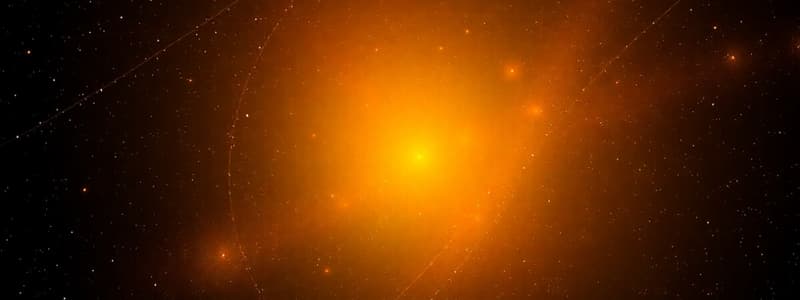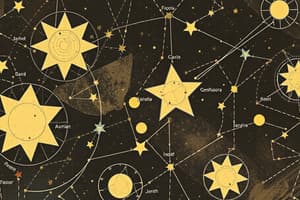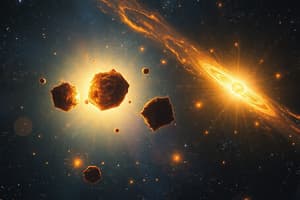Podcast
Questions and Answers
Which of the following structures is responsible for storing genetic information?
Which of the following structures is responsible for storing genetic information?
A mutation is always harmful to the organism.
A mutation is always harmful to the organism.
False (B)
What process occurs during cell division to replicate DNA?
What process occurs during cell division to replicate DNA?
DNA replication
In ionic bonding, electrons are ______ while in covalent bonding, electrons are ______.
In ionic bonding, electrons are ______ while in covalent bonding, electrons are ______.
Signup and view all the answers
Match the following types of chemical reactions with their descriptions:
Match the following types of chemical reactions with their descriptions:
Signup and view all the answers
What process generates heat and light in the sun's core?
What process generates heat and light in the sun's core?
Signup and view all the answers
The geocentric model of the universe is the current scientific consensus.
The geocentric model of the universe is the current scientific consensus.
Signup and view all the answers
Name the scientist who proposed the concept of the primeval atom that led to the Big Bang Theory.
Name the scientist who proposed the concept of the primeval atom that led to the Big Bang Theory.
Signup and view all the answers
Blue stars are ______ than red stars.
Blue stars are ______ than red stars.
Signup and view all the answers
Match the star life cycle terms with their definitions:
Match the star life cycle terms with their definitions:
Signup and view all the answers
What is the main factor that keeps stars stable?
What is the main factor that keeps stars stable?
Signup and view all the answers
What effect describes the change in wave frequency when a source moves?
What effect describes the change in wave frequency when a source moves?
Signup and view all the answers
The formula for speed is speed = distance divided by time.
The formula for speed is speed = distance divided by time.
Signup and view all the answers
Study Notes
Main Components of the Universe
- Planets, stars, nebulae, galaxies, neutron stars, and black holes are the primary constituents of the universe.
Stability of Stars
- Stars maintain their stability through a balance between the outward force generated by nuclear fusion and the inward force of gravity.
Nuclear Fusion Process
- Nuclear fusion in the sun's core involves hydrogen atoms combining to form helium, releasing energy as heat and light.
Sun as the Closest Star
- Our sun is the star closest to Earth.
Star Characteristics
- Stars vary in size, surface temperature, and color.
Temperature-Color Relationship
- Blue stars are hotter than red stars.
Hertzsprung-Russell Diagram
- This diagram illustrates a star's life cycle based on its temperature and luminosity.
Star Life Cycle Terms
- Main Sequence: The normal phase of a star's life where hydrogen is fused.
- Red Giant: A star expands after its hydrogen fuel is depleted.
- Supergiant: Large, bright stars in their later stages of evolution.
- White Dwarf: Small, dense remnants left after a star sheds its outer layers.
Heliocentric vs. Geocentric Models
- Geocentric: An outdated model that placed Earth at the center of the universe.
- Heliocentric: The current model that centers the universe around the sun.
Big Bang Theory
- The universe originated approximately 13.8 billion years ago from a hot, dense point that expanded rapidly.
Parallax
- Parallax is a method used to measure star distances using angles, with the formula d=1/p.
Doppler Effect
- This effect describes changes in the frequency of waves as their source moves, affecting both light and sound.
Red and Blue Shifts
- Redshift: Indicates objects moving away from us.
- Blueshift: Indicates objects moving towards us.
Cosmological Redshift
- Edwin Hubble discovered that galaxies are moving away from each other, supporting the concept of an expanding universe.
Fr. Georges Lemaître
- Lemaître proposed the "primeval atom" concept, a foundation for the Big Bang Theory.
Distance-Time Graphs
- These graphs visually represent the relationship between distance and time, revealing speed.
Speed Unit Conversion
- Conversion between kilometers per hour (km/h) and meters per second (m/s) is crucial in understanding speed.
- Formula: Speed (m/s) = Speed (km/h) ÷ 3.6
Speed Types
- Instantaneous Speed: The speed at any given moment.
- Average Speed: The total distance traveled divided by the total time taken.
### Speed Equation
- Speed = Distance ÷ Time
Acceleration
- Acceleration refers to the rate of change in velocity.
- Units of measurement: m/s².
Positive and Negative Acceleration
- Positive acceleration: Indicates speeding up.
- Negative acceleration: Indicates slowing down.
Newton's Laws
- 1st Law (Inertia): Objects remain at rest or in motion unless acted upon by an external force.
- 2nd Law (Force, Mass, Acceleration): F = ma (Force = mass x acceleration).
- 3rd Law (Action-Reaction): For every action, there is an equal and opposite reaction.
Car Safety and Newton's Laws
- Modern car safety features, like seatbelts and airbags, are designed based on Newton's laws of motion to mitigate injuries during accidents.
Traffic Accident Analysis
- Factors like acceleration, reaction time, and force play key roles in analyzing traffic accidents.
Reproductive Systems
- Diagrams of male and female reproductive systems help understand the structures and functions involved in reproduction.
DNA, Genes, and Chromosomes
- DNA: A double-helix structure discovered by Watson and Crick, carrying genetic information.
- Genes: Segments of DNA that code for specific traits.
- Chromosomes: Structures within cells containing packaged DNA.
DNA Replication
- DNA replicates to create an exact copy during cell division (mitosis and meiosis).
Punnett Squares
- These tools help visualize genetic crosses and predict the likelihood of offspring inheriting specific traits.
Mutations
- Mutations are changes in the DNA base sequence that can have positive or negative effects.
Mutagens
- Environmental factors that induce mutations are called mutagens.
Biotechnology
- Biotechnology involves using organisms to develop products, such as genetically modified organisms (GMOs) and medicines.
Atom Structure
- Atoms consist of protons (positively charged), neutrons (neutral), and electrons (negatively charged).
Chemical Reactions
- Color changes, gas production, and other observable changes indicate the occurrence of chemical reactions.
Ions
- Cations: Positively charged ions formed by the loss of electrons.
- Anions: Negatively charged ions formed by the gain of electrons.
Bonding
- Ionic Bonding: Involves the transfer of electrons between atoms.
- Covalent Bonding: Involves the sharing of electrons between atoms.
Types of Reactions
- Composition: Combining multiple substances to form a new compound..
- Decomposition: Breaking down a compound into simpler substances.
- Single/Double Displacement: Exchange of elements within a chemical reaction.
Law of Conservation of Mass
- Matter cannot be created or destroyed in chemical reactions.
Combustion
- Combustion refers to the burning of a substance.
- Complete combustion: A clean burn that produces minimal soot.
- Incomplete combustion: Produces soot as a byproduct.
Exothermic vs. Endothermic Reactions
- Exothermic reactions: Release heat into the surroundings.
- Endothermic reactions: Absorb heat from the surroundings.
Reaction Rate
- The speed of a chemical reaction is influenced by factors like temperature, concentration, surface area, and the presence of catalysts.
Studying That Suits You
Use AI to generate personalized quizzes and flashcards to suit your learning preferences.
Related Documents
Description
Explore the fundamental aspects of the universe including planets, stars, galaxies, and the processes that govern their stability and characteristics. Understand the nuclear fusion process in stars, the Hertzsprung-Russell diagram, and the life cycle of stars through this engaging quiz.





